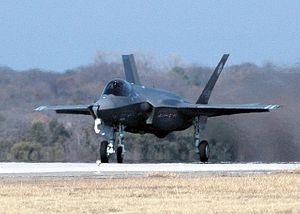Australia has on order 72 F-35 Joint Strike Fighter (JSF) planes. The problem? For years many have been saying that they’re simply… not very good. Yet public debate over this large purchase has been largely absent, though Canada’s rethink could drive up costs further for other nations.
Defense procurement stories from Australia in 2015 have largely been submarine, submarine, submarine, naval destroyer, submarine. However, between the back-to-back sea defense news and opining there’s one air story worth paying attention to: the large F-35 purchase. Australia is due to buy another 58 after a commitment from Tony Abbott last year, upping the force to a total of 72, at a cost of around A$98 million ($70 million) per plane. The total purchase cost will be, according to the Royal Australian Air Force (RAAF), around A$12.8 billion, and the same again for upkeep. The F-35s are to replace the RAAF’s 71 Hornets (six Super Hornets are currently in Syria and Iraq).
To replace the fleet of six Collins-class submarines with a dozen new ones may, in contrast, cost between A$25 and A$40 billion, depending on how much of the build will be done in Australia. The total cost of the long running JSF program is some $1 trillion. Nine ally nations are involved.
Since Justin Trudeau took power in Canada, Ottawa has apparently been rethinking its large order of F-35s. This is down to the cost, not efficacy, of the aircraft. And it’s this which has been fuelling debate for years now, since the project was begun almost fifteen years ago.
The F-35 isn’t operational yet, but it’s big a target of hate, and debate. The military blogosphere earlier this year saw an imbroglio over a leaked report suggesting that the F-35 did poorly in mock air-to-air combat against an F-16.
Others suggested that though there have been serious issues with the plane and design from day one, latching onto this report was little more than clickbait. What if the pilot was less experienced? What if some of those problems, such as the helmet, could be fixed? What were the exact trials the planes were flying under?
The criticisms of the F-35 have been swirling for a long time, in Australia and internationally, but have not gained serious purchase outside of those serious about defense and strategy or aviation, who tend to have varied, but strong, opinions. Its fighting capabilities against Russian planes were questioned back in 2008 when a RAND Corp presentation was leaked (you can no longer find it online) and Australian media picked up on it, boiling it down to one apparent slide, “Can’t Turn, Can’t Climb, Can’t Run.” RAND disputes this. It came up again in June, with a Coalition backbencher attacking the F-35 purchase.
Whether or not the F-35 can dogfight hasn’t been proven either way and really won’t be until a few are in the air with experienced pilots under real fire. But one of the tangential questions here became about the nature of warfare: Will the F-35 have to dogfight?
Andrew Davies wrote at the Australian Strategic Policy Institute (ASPI) blog that he’d like to see the plane carry more long range missiles and that yes, dogfighting is almost an antiquated idea. But ASPI’s Malcolm Davis makes the point, essentially, that given the F-35 cannot dogfight well the best strategy of the enemy would be to force it to do so.
Others have pointed out that the F-35 is hardly the first maligned plane in U.S. history. The F-4 Phantom suffered the same slings and arrows, and went on to survive battle with the more nimble MiGs during Vietnam (though as with all military history this is hotly contested: A better plane would have performed better). Still, as FighterSweep put it: “It’s fun to trash the new kid, especially the new kid that’s overweight, wears too much bling, and talks about how awesome it is all the time.”

































